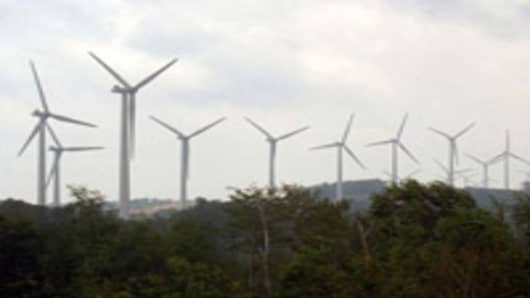“Transmission is the single largest strategic constraint for wind …but Texas has probably the most innovative policy for getting transmission built; it is increasingly a model,” says Randall Swisher, executive director of the American Wind Energy Association.
Texas currently has 5,249 megawatts (MW) of wind power - almost a third of the national total - supplying four percent of the state’s total electricity demand.
The Department of Energy recently released a study saying wind could provide 20 percent of the country’s electricity needs by 2030, if the transmission and other key problems can be solved.
The utlity commission weighed four different transmission scenarios approved by the Electric Reliability Council of Texas, the state grid operator, ranging from 12,000 MW to 24,000 MW. It chose the middle range plan known as 'Scenario 2' (see map below) which envisions 18,456 MW of new wind power.
It will cost an estimated $4.83 billion to build sufficient transmission to integrate the additional 18,000 MW of wind power into the state grid, leading some market watchers, including the inimitable Jim Cramer have suggestedto predict "everything wind is going to get a multiday move"as are a result of the Texas move.
Texas: Wind At Its Back
Texas, which has experienced a ‘wind rush’ since 2001, is a veritable jamboree of international wind developers – Florida Power & Light is the largest with 2,260 MW in operation and more coming.
Most active players in transmission are American Electric Power, Xcel Energy, and the ITCTransmission, a subssidiary of ITC Holdings Corp., which is the only national pure play.
Wind has also been embraced by one of the state's most famous entrepreneurs. T. Boone Pickens is in the early stages of an ambitious wind project there and recently launched a high-profile publicity campaign for his national energy plan centered around wind.
With some $9.4 billion in wind investment, Texas is the nation's clear leader.
Controversy And Contention
Among the states most important lessons is the need for a single national entity (probably the Federal Energy Regulatory Commission) to decide the critical issue of where to build power line corridors, which are never popular among local residents.
Some kind of Federal override authority is critical because utilities are generally regulated by the states, and some (notably Illinois and Missouri, sources say) have objected to having power lines cross their turf.
Senator Harry Reid (D-Nev.) recently introduced legislation giving Washington override authority (as do companion House bills) but its likely to be a contentious legislative process.
The federal-state nexus is spurring increasing talk about the need for a sweeping program, akin to interstate highway system launched by Pres. Eisenhower in the mid-1950s.
The DOE-funded study estimated it would cost $60 billion to build the transmission infrastructure needed to handle 400,000 megawatts of wind power.
Texas, however, enjoys some advantages in solving this riddle on a state-wide basis.
It is its own electricity market, while most states are part of regional electricity markets, requiring cross border negotiations.
(Siting transmission lines is also easier in relatively lightly populated Texas.)




